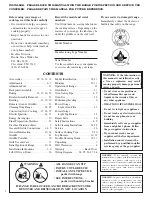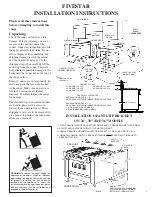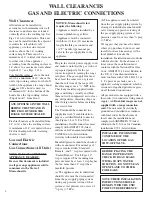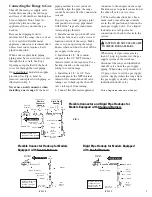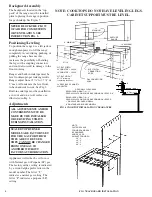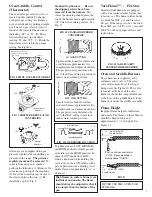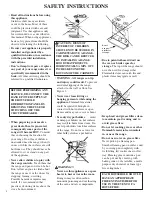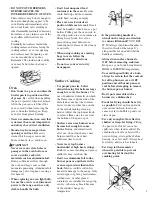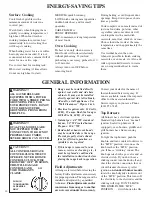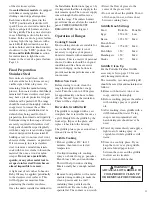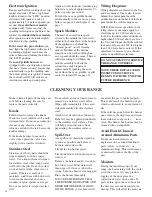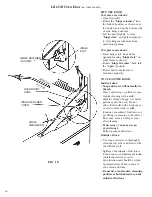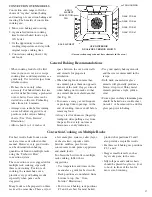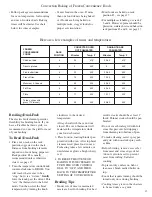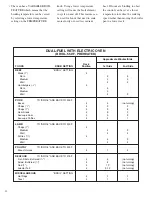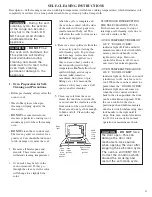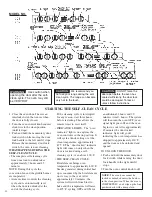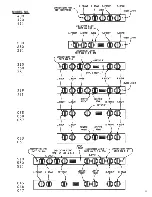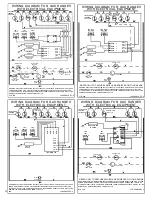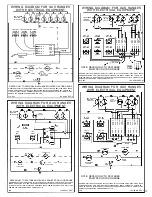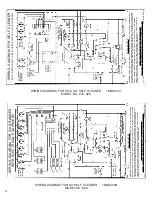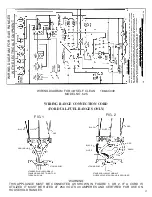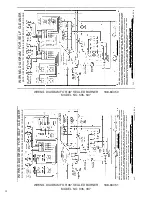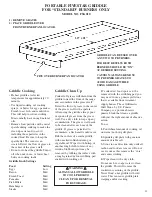
DO NOT ATTEMPT TO SERVICE
THE RANGE YOURSELF.
NOTE: THESE INSTALLATION
INSTRUCTIONS SHOULD
REMAIN WITH THE UNIT FOR
FUTURE REFERENCE.
Electronic Ignition
Ranges and built-in cooktops have top
igniter electrodes. When a top burner
knob is turned to the “LITE” position
electrodes will spark at a rate of
approximately 2
1
/
2
pulses (sparks) per
second.
On sealed burner models
equipped with “flame sensing” the
sparking will stop once the burner has
ignited. On
standard burner models,
after ignition, rotate the knob slightly
clockwise to stop sparking.
In the event of a power failure
you
may light the top burners with a match
by holding a lighted match near the
surface burner and turning the knob to
the “LITE” position.
Oven and griddle burners
are
equipped with a spark ignition system
that has a “flame sensing” feature that
automatically stops the sparking once
the burner pilot gas is ignited. Turning
the control dial ON will activate an
electronic module and send pulses
(sparks) to all electrodes (including top
burners) at a rate of approximately 1
1
/
2
pulses (sparks) per second.
To light the oven or griddle burner
pilot manually in the event of a power
failure see page 14 and Figure 13 on
page 7.
Spark Modules
The heart of an electronic spark
system is the module that is located
either in the burner box, at the bottom
of the appliance, or behind the
“dummy panel” on self cleaning
models. Modules at the bottom
location can be reached through an
access panel under the range. There is
sufficient wiring to withdraw the
module assembly to check the
connections, make repairs or
replacement. If sparking does not
occur when the oven, griddle, or grill
control is turned ON see page 32.
Wiring Diagrams
Wiring diagrams are located in the Use
and Care manual. One is also located
behind the control panel near the
griddle knob or on the back of the false
panel under the self-cleaning oven.
NOTE: Burner rates specified on the
rating plate of your range apply for
elevations up to 2,000 feet above sea
level. For locations where altitudes are
higher than 2,000 feet above sea level
the b.t.u. rated input should be reduced
four percent for each 1,000 feet higher
than 2,000 feet above sea level. If this
adjustment is necessary, you should
contact a qualified serviceman.
CLEANING YOUR RANGE
Make certain all parts of the range are
cool before cleaning. Be sure to
replace the parts correctly.
Knobs
Pull forward to remove the knobs.
Wash in a water solution with a mild
detergent mix. Do not use an abrasive
cleaner or any abrasive action.
Abrasive action will scratch away the
knob markings.
If the knobs become loose on the
valve stem, spread the valve stem
slightly with a small screwdriver.
Stainless Steel
Stainless steel body parts should be
wiped regularly with hot, soapy
water. Use a liquid cleaner designed
for stainless steel when soapy water
will not do the job. Do not use steel
wool, abrasive cloths, cleansers, or
powder. If there are encrusted
materials, soak them with hot towels
to loosen the material, then use a
wooden or nylon spatula or scraper.
Do not use metal to scrape stainless
steel.
Do not allow citrus or tomato juice to
remain on a stainless steel surface.
Wipe spills immediately. Citric acid
will permanently discolor stainless
steel.
A light coat of oil such as Johnson’s
Baby Oil may be applied periodically
to the stainless steel surfaces. This
will help prevent moisture from
penetrating the stainless surfaces.
Spill-Over
Any spill-overs should be wiped up
as soon as possible and before it
burns in and cooks solid.
Lift off the top burner grates.
Lift up the front of the burner pan to
remove it.
Remove the burner and let it soak in
hot, sudsy water. Most stains will
then wipe off; if not, scrub with a
strong, but non-abrasive cleaning pad.
Rinse the burner thoroughly.
IT IS VERY IMPORTANT THAT
THE BURNER BE DRAINED AND
DRIED BEFORE REPLACING IT
IN THE RANGE. A wet burner will
not allow the gas to ignite properly.
This could result in a build-up of gas
which could result in an explosion or
fire.
If the spill has gone below the burner
pans, remove the drip trays and wash
them with hot, soapy water . . . rinse
clean. The burner box bottom may be
cleaned with a damp cloth.
Avoid Harsh Cleaners
Around Aluminum Parts
Do not use harsh cleaners or
degreasers on or around functional
parts (valves, controls, etc., or
aluminum tubing). This will damage
or drastically reduce the life of the
part.
Moisture
During the initial heat-up of your
range, the heat mixing with the cooler
air in the oven cavity may produce
fogging of the door glass or a
collection of water on the door. To
prevent this, open the oven door for
the first few seconds of initial oven
heat-up. This will allow the moist air
14


